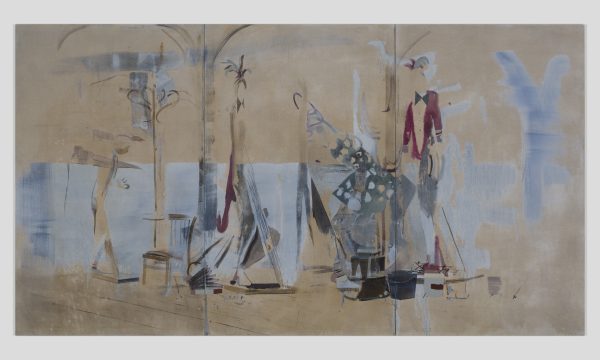Trying to figure out what marks contemporary literature as contemporary is a deceptively complicated job because the concept of contemporaneity at stake is itself complicated. Those complications are sustained by the unqualified way that the word contemporary seems to refer to both a quality of being with (con) in time (temp), in the colloquial sense of something being ‘of its time’, and to simultaneously identify our current moment as a historical period, a period that we’re historicising as we live it because one of the qualities that distinguishes it from previous periods is an obsession with now-ness.[1] Within discussions of the arts, this doubling has been theorised at greatest length by those studying visual culture (usually vis-à-vis contemporary art, which John Douglas Millar has rightly pointed to as contemporary culture’s placeholder – its unelected parent category), not least because premonitions about post- and post-post-modern life put forward during the late-twentieth century were most popularly obsessed with the growing presence and influence of images.[2] All such forethoughts focussed critical approaches to twenty-first century culture in terms of the visual: what can be seen (the visible) and ways of seeing it (visibility and our visualisations).
On the surface of contemporary life, the compression of multi-megapixel cameras into networked smartphones that feed data-streams like Instagram via one-click apps suggest those premonitions were well founded. What excites me and some other poets who have been at the forefront of the Conceptual Writing scene is a simple observation that problematises such premonitions and the visual bias they ground. In short, although the surface of life is constantly being flooded with images, its depths, structures, flows and our interactions with them have proved to be more dependent than ever on written language, not least because all computational data is a kind of emic, alphanumeric code. The really new features of twenty-first century life are reforming life under the surface – in relational networks that we only have limp metaphors to describe, like ‘the cloud’ – and so we need to read everything and anything legible below the surface in ways that go beyond seeing. As writers we seem to ask: what might it be interesting to write if we were to wager that, rather than being over-written by the visual, the contemporary world has become more fundamentally textualised than any period before it?[3] And as readers we seem to ask: what kinds of literacies might we need to read these new textualities forming on and below the surface?
I don’t want to stray from an observation to a clumsy truth-claim, I don’t want to rehearse arguments about the textualisation of everything, and nor do I want to resuscitate out-of-date ideas about the difference between ‘visual’ art and literature. But I do want to take the above speculation seriously and to think about the importance of technical mediation to the changed horizons of new writing – to the new now-ish-ness of contemporary writing and the unprecedented (im)mediacy of public language acts. One of the strengths of the best Conceptual Writing is that it steps outside of the should-be territory defined by previous poetries and the nineteenth-century’s epistemology of literature to concern itself with, and even begin amongst, what Gerald Bruns would call literature’s elsewheres and I have started to call the (im)properly extra-literary.[4]
One aspect of contemporary life is that there are more people than ever producing and consuming public language, and more private language becoming public than ever before: there’s more language, and a higher proportion of it ends up being public. This is happening in obvious ways, which have become common news issues over the last ten-to-fifteen years, but also in less obvious ways, as the NSA surveillance scandal has paradoxically obviated. Digital software-hardware combinations have standardised desktop publishing, seemingly naturalised the database as an organising principle for life, and now aggregate flows of data in constant streams around the world in volumes way beyond the limits of what we can actually read. Every time we type on a computational device our keystrokes are being published by default, to some degree of discretion, every few seconds. They’re saved automatically into the file we’re making, onto the archive drive of our devices, onto the linked backup servers our workplaces have installed, and evidently onto the monitored databases of international surveillance groups. That’s an edition of four before you’ve even finished a sentence; and at least philologically speaking, it seems to me important to remember that the word ‘publish’ derives from the Latin publicare (to make public) via the middle English publicen (to get rid of, to let go of). What this kind of immediate and invisible reproduction demonstrates is that often, now, writing and publishing are the same action – that self-publishing is something we do to ourselves by default, even if only by allowing our writing technologies to do it for us.[5]
By the broadest theories of media, one can argue that languages themselves should be understood as a technology. By the corresponding sociologies, members of each society co-develop a version of this technology to mediate their expressions and relationships with both one another and their self-understanding. By more narrow theories of media, one can argue that the technologies of language are only the apparatuses made to carry a language, rather than any language itself. Any sociology that involves such an idea has, at some point, to distinguish the carrier (medium) from the carried (language), and to do so in terms of technics: the former has to be a technical construction, something made by people, and the latter has to be something else.[6] Figuring out what kind of ‘something else’ language might be has in the past depended on distinguishing between some independent presence of language (as if language were a thing-in-itself regardless of people) and the technicity of its being represented (language as a thing-in-itself that people produce representations of). These are natural language theses, as when people maintain that language is natural because, for example, the word is God’s and so we can only speak imperfect second-order representations of His true word.
Without some such faith that language has a natural state, status and presence, it’s difficult to think of writing as anything other than a representation of a non-presence, or rather, a present representation, as many high modernists believed. The idea that any language is anything other than the collective history and practice of that language being enacted – its materialisations – plus the temporality of those representations as material – material that only has a ‘being’ insofar as it gets engaged with – dissolves, like a faith unravelled, with the demystification of the idea that our languages could’ve ever been anything other than made and re-made by societies. Written language isn’t ‘something else’, something other than what we make it, something with an innate constitution. Language acts are representations of a schema of representations, they’re representations of representations, and all representations try to re-present something that they’re not. Language is the thing in between, in the middle, the medium; but it’s also always socially constructed and the mediator of anything made public in or with (within) it. The 140-character limit on Twitter doesn’t only constrain Tweets; it has echoing effects on attention spans, contractions of spelling and punctuation, and the skills expected of marketeers. It’s not that words no longer represent concepts, as the bandying of Marshal McLuhan’s famous ‘the medium is the message’ can mislead people to think, but that we have to recognise the increasing significative power of all the re-mediating processes and institutions that intersect to make any language act public.[7]
Every language act re-mediates the mediality (the in between-ness) of its language in a specific way, and every act enters into sequences of language networks, networks that in turn re-mediate the remediation…etc, etc. As the networks become more accelerated, pervasive and invisible so too do the acts. It should come as no surprise that some of the poets who inherited the consequences of the above debates are interested in exploring how the newly accelerated immediacy of language is, perversely, an expression of the mediatisation of contemporary writing in the contemporary world generally.
I’m calling this change perverse because it flips the modification performed by the prefix im-, and so formulates a productive paradox: Now the im- in immediacy can be read as signifying a ‘movement toward’ the quality of being mediate, rather than signifying a ‘lack of mediality’ or a being ‘not mediated’.[8] That second, negative sense of the prefix im- has until now modified the meaning of immediacy to signify an experience of direct contact between an I and another thing-in-itself, a contact that is direct because there’s nothing in between them. I’m not claiming that this definition is now somehow wrong – that now, when people have sex, it’s necessarily less immediate than it was, say, one hundred years ago – only that this definition is too simple if we’re going to try to analyse our experiences of writing and reading in our mediatised age. If language-in-itself is a constructed representation then any immediate contact with language must be directly with a representation plus the schema(s) it’s situated in. Representations can’t be themselves without a context because the (albeit real) present-ness of a representation is insufficient-in-itself by definition. Contemporary public language has productively extended this insufficiency by converting it into a hyper-situated-ness, linking links to links – always elsewhere, always more, always multi-directional.
But what about the status of the I that comes to that immediate instance of direct contact with language-in-itself, language as a multiply-situated, impermanent and insufficient representation? The term mediatisation turns the stem noun mediate into a verb, which is a form (turning nouns into verbs) that seems to irritate a lot of people. In this compound the suffix -isation literally means ‘to make x’, and it gets us a little closer to articulating the tidal movement (below the surface, out of sight) of our contemporary medial condition.[9] The specific constellation of significant media at our ‘now’ moment in history structures something more than a media-scape for culture – something more effective than a passive backdrop – something more like a mediated-and-mediating-scape. Under the surface of the language we read, the tidal movement of these interacting media seems to mediate everything that has contact with it, to unlimited, accelerating, and ever-more pervasive extents.
Short of ethical objections, there’s no reason to think that in this adolescent era of digitally-inflected post-humanism the human authorial subject should be invulnerable to this tide. In short, we can’t just use these networks and networked technologies and maintain whatever integrity we come to them with; when we engage them ‘they’ (a clumsy shorthand, I know) begin a process of mediating us with soft and hard power. Some of those operations and their affects are visible, others not: Every time the predicative typing software on our mobile phones overwrite the letter order we actually key, or our web browsers syphon data about our search behaviour so as to customise the adverts we’re shown, the medial network is mediating our use of the medium and us too in turn. These interacting media are doing so behind the veil of an interface, behind the lumpen presence of hardware, and behind our seeming ownership of both, according to chains of algorithms that are so long and so many and so changeable that we can’t possibly see how they’re re-mediating us. When I make a Google account to embed their Analytics HTML in a website I manage, and start to worry about the stats it returns, I’m performing my own interpellation – I’m pretending to be the policeman and hailing myself.[10]
These are crude examples of what I’m calling the mediatisation of writing, and of the fact that our medial condition will depend more and more on textualisation as the virtual and actual increasingly combine to mediate whatever it is that our contemporary reality is becoming, at least at the level of code-algorithm and software-hardware interactions. Lots of smarter people than me have pushed our knowledge of these emergent conditions further and more intelligently than my sketch above. In tandem with their technical and philosophical advances, some poets have been willing to hyper-extend these re-mediations and hyper-extend the cultural register of poetry by again re-mediating such formations of language – this was the modus of Conceptual Writing – nominating such formations to a context where people are willing and able to read differently. The best such work has allowed us to experience otherwise unimaginable aspects of the fact that public language has never been so unstable.
The forms of languages, their ranges, their userships, and the demographic variety within each language’s usership, all only add to the historical baggage that inevitably builds up as a language gets older. When lexicographers add webspeak terms to the Oxford English Dictionary news broadcasters react with chatter about how language is changing. But to do so by looking at the lexicon is to miss the more dramatically new change, which is fundamentally one of materiality – it’s a change in what language is (as a multiply-situated, impermanent and insufficient re-re-re-…representation) not necessarily what it’s used to say. Contemporary public language is clonable and fluid, overlaid and reproducible on-demand; it’s polymorphic and regulated by vectors, relayed from spinning magnetic discs elsewhere and as unstable as the media that has mediatised our ways and means of writing within it. Now it’s easy to feel like the language act is more immediate and dynamic than the supposed authorial subject behind that act. Now, more than ever, public language seems less and less like an expression of some already-public subject and more and more like that subject’s post-human proxy, my all-too-real avatar. Administering a popular Twitter account, for example, can make that authorial subject’s other contributions to public life seem inadequate. Mediatisation leads to our artificial subjectivity becoming more real (or more really dynamic) than any other aspect of our self-subject-hood. It’s as if via our artificial artificial subjectivity we can become more immediate and immediately engaged with the contemporary ‘real’ world than any pre-, un- or less-medial subject-position could possibly allow.
How and what do our avatar societies output as writing? What forms of literature are being written at the extremes of our contemporary real that weren’t previously possible? Automated writing services that compose new texts using a method called narrative analytics are a kind of limit-less limit case. For example, the Long Tail algorithm has been used to write over 890,000 new books, which have been published by Icon Group International since 1999. So-called narrative analytics programmes not only analyse a dataset for you but also narrate that analysis and produce new findings.[11] Until now the latter at least – the production of new insights – which is to say, scientistically, the production of new knowledge – had been assumed to be the preserve of human authorial subjects. I can’t imagine a properly contemporary poetry, in the complicated double sense of contemporaneity that we’re now working with, that doesn’t explore the modes of writing or questions raised by these kinds of technical and non-literary developments. They cast a technical foreshadow in front of (before) all new writing. Poets who promblematise the shade of this foreshadow, like those amongst the Conceptual Writing scene, do so by taking the risk of producing improperly extra-literary acts that often can’t or aren’t seen to be poetic. They hyper-extend the new status_anxieties of poetic voice and the seemingly infinite ambience of its formations.[12] The production and circulation of such work approaches the fact that there’s never been so much public language and yet public language has never been so insufficient, and tries to turn that fact into a conceptually productive (and shared) problematic. The (im)mediacy of much such work manages to quickly capture, then just as quickly lose, the interest of lots of poetry readers. Given that the prefix im- is a variant spelling of in-, we might better bend English grammar to describe the (im)mediate public language acts as inmediate. I suggest so not least because the artificial artificial subjectivities that we re-re-re-…produce through inmediate public language acts seem to make the mediatisation of writing starkly legible where it might otherwise remain invisible and culturally unread.
[1]As different from, for example, the futurology of modernism: new, new, new…
[2]As John Douglas Millar told me, winter 2013.
[3]Robert Fitterman re-defined the practice of Conceptual Writing as a wager on the unexpected textualisation of twenty-first century culture during a ‘Literature and the Law’ seminar that I convened for the University of Leeds, March 2014. See also Fitterman’s Just Another Soft Machine published by Veer Books (London), 2014.
[4]Gerald Bruns developed the idea of literature’s ‘elsewhere’ (or ‘otherness’) from the work of Maurice Blanchot and Hugh Kenner. See, for example, Bruns’ Maurice Blanchot: The Refusal of Philosophy published by John Hopkins University Press (Baltimore), 1997.
[5]For a fuller discussion of self-publishing and Conceptual Writing see my article ‘Conceptualist Reading Performances as a Praxis of Publishing’ in Journal for Writing in Creative Practice vol.6:3 published by Intellect (London), winter 2013-14.
[6]Understanding ‘technical’ objects as products of human innovation, and as thus distinguished from ‘natural’ objects, is an extension of the philosophical difference between technical (techne) and empirical (episteme) qualities. See, for example, Bernard Steigler’s Technics and Time book series (1994, 1996, 2001, to date), which have been published in English translation by Stanford University Press (Redwood), 1998, 2008 and 2010.
[7]Marshall McLuhan first proposed the phrase ‘the medium is the message’ in Understanding Media: The Extension of Man published by McGraw-Hill (New York), 1964.
[8]All citations are from OED Online published by Oxford University Press and accessed July 2014.
[9]Ibid.
[10]This characterisation refers to Louis Althusser’s ‘Ideology and the Ideological State Apparatuses’ (1970), which contains his famous example of how individuals take part in their own subjectification if they self-identify as the addressee when a policeman shouts ‘Hey, you there!’.
[11]The Icon Group International is an imprint begun by Philip M. Parker whose research work led the development of the Long Tail programme. Parker alone is the listed author of well over 100,000+ automated books already, available in e- and print on demand versions.
[12]For a longer speculation on how the problems of contemporary poetic voice seem to be characterised by certain status_anxities see my article ‘Status_Anxieties’ in Convolutions: The Journal of Conceptual Criticism vol.1:3 published privately (New York), September 2014.




